Back in January, Meindert Dijkstra, from the faculty of Universiteit Utrecht, informed me that his colleague, Karel Vriezen, had
This came as quite a surprise because of its absence from Yosef Garfinkel's otherwise-excellent, exhaustive LMLK corpus published in BASOR 271 (August 1988), & Andrew Vaughn's additional work in the 1990s (formally published in "Theology, History, and Archaeology in the Chronicler's Account of Hezekiah").
"Kefireh", as it was named in Conder & Kitchener's ambitious/successful survey of Western Palestine (SWP) conducted in the 1870s, is situated just north of modern Qatana ("Katanneh" on this map):
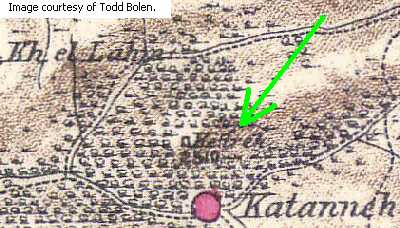
(And a bold-capital-letter THANKS to Todd Bolen for making this image available! If you'd like to own the entire hi-resolution map, please visit his Life in the Holy Land site, especially the "Survey of Western Palestine: The Maps" CD page.)
But I was in for an even bigger surprise when I learned that Dr. Vriezen's
Nor does it appear in another otherwise-excellent reference book, "Archaeological Encyclopedia of the Holy Land" by Avraham Negev & Shimon Gibson!
It's not too hard to see why it's been overlooked, at least if someone were using this SWP map due to how the illustrator blended it into the terrain symbols (thanks again to Prof. Bolen for helping me find it).
However, LMLK VIP Anson F. Rainey & co-author R. Steven Notley get kudos for at least mentioning the site in their new landmark work, "The Sacred Bridge"! While discussing the location of the 4 towns in Joshua 9:17, p. 126 states: "Chephirah is easy since the perfect toponym is preserved at Khirbet el-Kefirah." Here's a small section of the map accompanying the text, whose caption reads "The Battle of Gibeon":
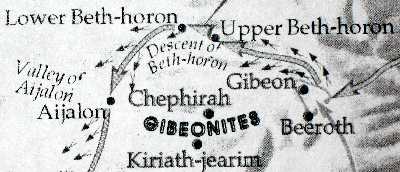
Much easier to see in that one!
Aside from Joshua 9:17, it's also mentioned in 18:26, & not again until the redundant passages of Ezra 2:25, Nehemiah 7:29, & apocryphal 1Esdras 5:19. All 4 citations merely name it in lists; apparently no specific actions took place there worthy of recording.
Karel J. H. Vriezen described the results of his
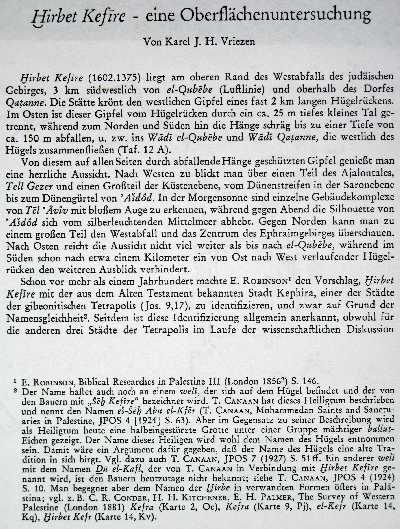
Unfortunately for me, it was written in German, so it would be a bit tedious for me to translate here, but I'll include a few snippets. I am German illiterate, so please refer to the original publication for accuracy--my English quotes below are only ballpark estimates!
The ZDPV article's title is "Hirbet Kefire - eine Oberflachenuntersuchung" (a top-level survey/investigation). The first paragraph gives its coordinates as "1602.1375", & says it's on a 2-km summit situated at the upper edge of the western wastelands of the Judean mountains, 3 km southwest of el-Qubebe ("el Kubeibeh" on the SWP map), just above the village of Qatanne.
He visited the site while excavating a Lutheran Church in Jerusalem with Ute Lux from 1970-1974. It was not a very well known site at the time, but had a promising description from some visitors. It became the site of an apprenticeship/training course by the Deutsches Evangelisches Institut under Lux's direction on September 15, 1970. There they collected ceramic shards on the upper terrace as well as the north & east slopes. Dr. Vriezen revisted the site in June & July of 1973, then again in March & July of 1974. The article itself was written on "7.10.1974" (I'm guessing that's October 7th, not July 10th).
Here's a lo-res image of a nice fold-out map in ZDPV (Abb. 1):
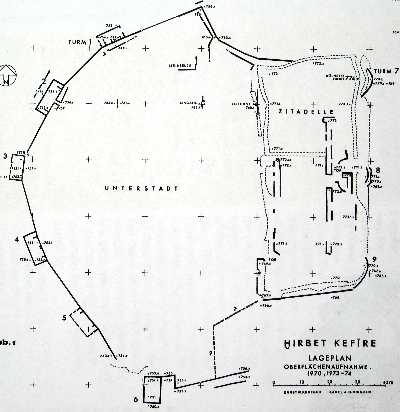
As you can see, there was a citadel in the east/northeast corner of the site at the summit of the hill, & a lower city on the large terrace west of it. What you can't see in this image are 3 graves situated to the northeast of the site; drawings of their shapes are provided in Abb. 2 on p. 141. Tafel 12-15 show photos of the site, which is terrific to have since I've been told that the site has now been built over again in modern times.
He found evidence for 2 periods of ancient building activity--the Iron-II & Byzantine. Abb.3 on p. 144 & Abb. 4 on p. 145 show drawings of pottery cross-sections from Early Bronze, Iron I, & Iron II; Abb. 5 on p. 147 shows some Hellenistic ware; Abb. 6 on p. 148 shows some Roman ware; & Abb. 7 on p. 150 shows some Byzantine ware. It was a site with quite an extensive history of occupation! Of course the most interesting part begins near the bottom of p. 143:
"Auf zwei henkeln dieser Gruppe wurden Konigsstempel festgestellt, einer mit dem vierflugeligen und einer mit dem zweiflugeligen Symbol.
On 2 handles of this group King's-stamps were analyzed, one with the 4-winged & one with the 2-winged symbol."
Dr. Dijkstra informed me that they were both surface finds. Here's Footnote 22 attached to the end of the sentence:
"Der Abdruck des vierflugeligen Symbols ist leider sehr schlecht erhalten; er gehort wahr-scheinlich zu den umribhaften Darstellungen. Vgl. P. Welten, Die Konigs-Stempel (Wiesbaden 1969) S. 10 ff. Bei unserem Exemplar sind der Korper und die vier Flugel noch zu erkennen, der Kopf aber nicht. Besser erhalten ist der Abdruck des zweiflugeligen Symbols; er gehort in die Gruppe der ausgefuhrten Darstellungen. Im Zentrum hebt die Scheibe sich deutlich ab; die leicht geschwungenen Flugel enden in etwas hochgezogenen Spitzen; 'Kopf' und 'Schwanz' sind deutlich erkennbar, wobei der 'Schwanz' durch zwei Langslinien aufgeteilt ist. Bei beiden Beispielen ist die sonst vorhandene Inschrift nicht zu sehen.
The impression of the 4-winged symbol unfortunately is poorly preserved; it probably belonged to the schematic representations. (Here he cites pp. 10-6 of Welten's 1969 book, which discuss the x4x seals.) In our example the body & the 4 wings are barely recognizable, not even the head. The impression of the 2-winged symbol is better preserved; the gracefully drawn wings end in uplifted points; 'head' and 'tail' are clearly recognizable, whereby the 'tail' is divided by 2 longitudinal lines [amazingly similar verbiage to my objective 'APL' used in my 2004 book]. In both examples the inscription usually available is not to be seen."
However, in our correspondence, Dr. Dijkstra said that one of the handles does not have any seals, even though it is obviously Type 484. The other, which is shown in a photo in Tafel 15.C, has a very deep impression of an x2x. He identified it as a Z2D, observing a "Zayin at the right side of the tail"; however, when I first saw the 1975 photo, I immediately felt it was not a Z2D, but a G2T based on its apparently inverted rays/beams in the icon's tail. But since the photo is so dark, I can't say for sure that what I perceive to be the inverted form of the rays/beams is not merely shadows, in which case the icon seems to resemble the H2D. (In previewing my electronic publication of it last night, Floridian collector/researcher, Michael Welch agreed with me.) We won't know for sure until I can obtain a better photo, which I've been assured I'll receive.
For now, I just added a standard cropping per the G2T design, & added it to the x2x page of The LMLK Research Website (presently #84 thereon; it's a 10:00 orientation, xxx ware, no incisions). I'm also going to accept at face value his statement that the other handle is completely stampless, though now that I've translated the original publication, I'm going to request a detailed photo of it as well.
As an interesting sidenote, Tafel 15.D shows the typical pre-fired Plus mark on a small handle (again, 1 of 2 found).
The final & very long section of his article discusses Biblical/historical views of the site, followed by a conclusion on p. 158 that includes this LMLK sentence:
"Die Auffindung zweier Krughenkel mit Konigsstempeln schliebt die Lucke, die es in der Distributionskarte dieser Stempel im nordlichen Bereich ihrer Verbreitung zwischen dem Hugelland (Geser) und dem Zentrum des Berglandes (el-Gib) gab.
The discovery of 2 jug handles with King's-stamps closes the gap, which was in the distribution map of these stamps in the northern area between the Hill country (Gezer) & the center of the Mountain country (el-Jib)."
Indeed it does fill an important gap ... not quite as big now as it was in 1974, but still a gap as you can see on my updated site map.
Revue Biblique vol. 84 #3 (July 1977; a French journal published by Ecole Biblique) also contains an abridged summary/report from K. Vriezen on Khirbet Kefire in its "Chronique Archeologique" section spanning pp. 412-6. Here's the first page in your face again, & an equivalent French site drawing based on the German one in ZDPV:
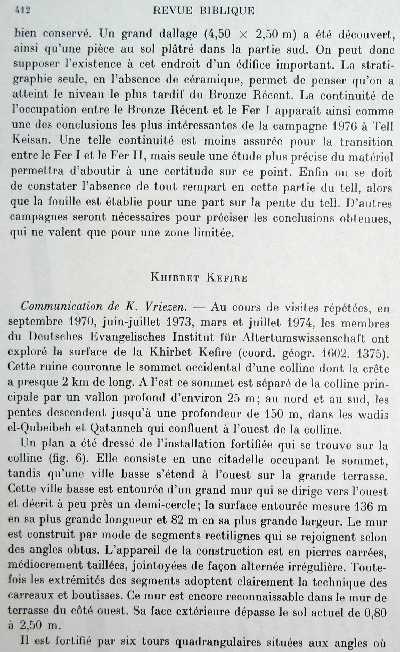
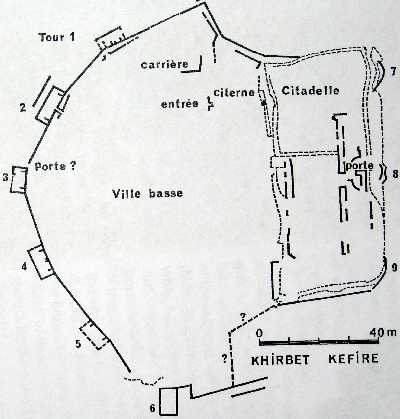
Since my French translation skills are every bit as unreliable as my German, I'll cut right to the chase with this sentence from p. 415:
"A la céramique du Fer se rattachent deux anses à estampille royale.
To the Iron-age pottery belong 2 royal-stamp handles."
It's rather amazing that even Andre Lemaire didn't catch this & bring it to anyone's attention during the 1980s or 1990s, but I've done my best to bring it to everyone's attention now!
If anyone knows what the modern Arabic word "Kefireh" for the Hebrew word "EKFYRE" (Strong's 3716) means, please post a comment. I noticed that in Joshua, this is the only one of the 4 cities named with a definite-article Hey prefix & feminine(?) Hey suffix; so it would seem to read "The Chephirah", similar to "KFYR" (Strong's 3715) for "young lion" in numerous other verses, except for the common Aramaic translation of "villages" (KFYRYM) in Nehemiah 6:2.
Was this "The Young Female Lion", or "The (feminine) Village", or something else?
Song of the week: "Lost in the Travel Section" by John Archer (click the song title to visit Amazon; click here for a 27-second sample; 360kb).
G.M. Grena

1 comment:
Courtesy links to relevant comments posted at the LMLK Wordpress version, & others at Prof. Chris Heard's Higgaion site.
Post a Comment